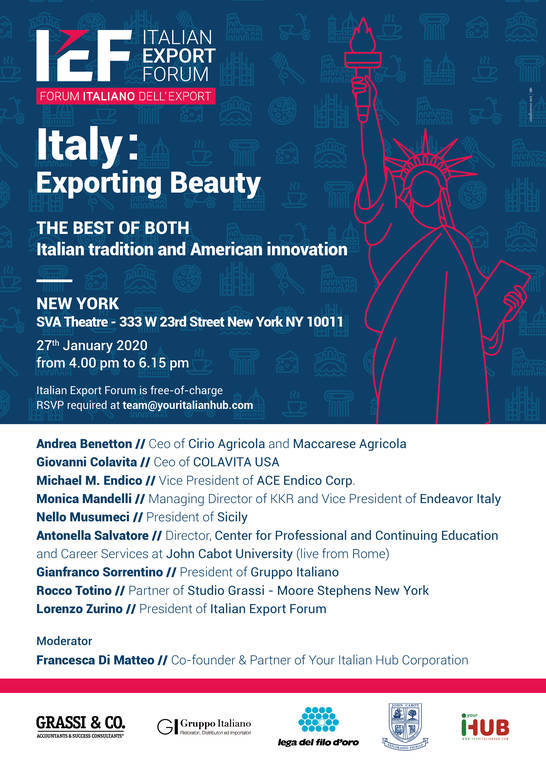“Stronger together”: The Secret of Promoting the Made in Italy Brand.
In the past decades the “Made in Italy” brand has conquered America, from food to fashion. What is in your opinion on the status of 'Made in Italy' in today’s market, particularly within the food industry?
“Let’s start by prefacing that Italian products have always added great value to foreign markets and that’s a fact, a chance that others don’t have. To be clear, we didn’t create this valuevout of thin air, we found it thanks to our identity, which stems from an incredible reality made up of ancient municipalities, each with their own traditions.
We have been less capable than others to make good use of this immense heritage and today we understand that in order to remain attractive we have to elevate our competitiveness by focusing on things such as technological investments on infrastructure and increasing the level of the workforce involved in the production. We have to do more.
To remain relevant we have to keep up with the times, interpret the evolution of the consumer and continue to propose a product imbued with the values unique to our tradition. We are no longer able to remain attractive with the 'Made in Italy' label alone.”
In your experience, what do Americans expect from Italian products?
“The American consumer - but in general any evolved consumer - requires a product that is not only ‘physical’ but also ‘emotional.’ When someone purchases an Italian product today, they are also purchasing a part of culture, our culture, our way of life, because all of this takes place in a specific environment, Italy, which is considered unique and irreplicable.
I’m thinking of the fashion world and our great interpreters who are constantly presenting masterpieces with each of their collections, or of the food coming from the different regions of our incredible country: from parmigiano reggiano to mozzarella di bufala from Campania, from prosciutto crudo to Calabrese soppressata, from spaghetti to orecchiette; products that speak to the expert skills and traditions of small businesses or to the advanced technology of our great manufacturing companies. Between its DOP and IGP products, Italy has over 200 specialties, unique for their flavors but also for the traditions they represent. When consumers purchase an Italian product, they ultimately want to live a bit of our tradition, to make it their own.”
Italy’s success is largely due to the creativity and entrepreneurship of our small and medium businesses. What should we do to help them position themselves on the American market and manage their presence here?
“Creativity and entrepreneurship alone are not enough, there should be an integrated system to support our businesses and allow them to present themselves in a more ‘institutional’ manner in the market. I’m thinking of France, which has made its embassies the institutional promoters of its businesses. We, on the other hand, have a network of delegations, with undefined roles, just think of embassies and trade agencies, in addition to the many difficulties that the government with its choices is not helping to resolve.”
In other countries, companies work together, and as we know, we are stronger together and today size is a critical factor when it comes to entering a new market.
“Our production chains should organize themselves better and dedicate more resources to trademark protection, because if we look at the data on fake ‘Made in Italy’ products (known as “Italian sounding,” ed.) we notice that it amounts to a value of up to 100 billion dollars. Low-cost imitations have increased by almost 70% in the last 10 years and this means that our production chains as well as our politicians haven’t been doing enough.
Specifically in the American market, we find mozzarella, parmesan, provolone produced in Wisconsin, California, or in the very state of New York in open violation of the property rights of the original brands. We even find Pecorino Romano (in those same areas) with no trace of sheep’s milk!”
And then there’s the issue of tarifs and commercial policy. Here too, they should intervene.
“Certainly. In 2019, the US commercial strategy was to protect internal production to the detriment of those of the European Comunity by imposing new trade tarifs amounting to 7.5 billion dollars. And the country to suffer the most from this in the food sector was Italy. The Italian Trade Agency estimates a burden of about 120 million dollars on a selection of about 500 million dollar’s wortg of products such as cheese, liquor, meat, preserves, and fruit. The essence is that it's not just the companies making the products but also the final consumers who are being penalized by these difficult relations. Central governments should initiate negotiations with the US government in order to find mutually beneficial solutions.”
---
Attendance to the "Italian Export Forum" is free-of-charge
January 27th 2020
from 4.00 pm to 6.15 pm
Please RSVP team@youritalianhub
NEW YORK
SVA - School of Visual Art - SVA - Theatre
333 W 23rd St
New York, New York



































i-Italy
Facebook
Google+
This work may not be reproduced, in whole or in part, without prior written permission.
Questo lavoro non può essere riprodotto, in tutto o in parte, senza permesso scritto.